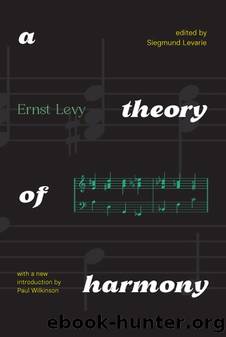A Theory of Harmony: With A New Introduction by Paul Wilkinson by Ernst Levy; Siegmund Levarie; Paul Wilkinson

Author:Ernst Levy; Siegmund Levarie; Paul Wilkinson
Language: eng
Format: epub
Publisher: State University of New York Press
Published: 2023-01-15T00:00:00+00:00
Following the numbers in their natural array, we obtain a zig-zag motion, consisting of triad pairs having a common generator:
The better a cadence is balanced, the more convincing and definite it is. The balance can be read from the table. For instance:
Suppressing one term out of two in the last example, we obtain an elliptic version:
A more subtle balance is realized in this cadence:
The cadence is entirely on the minus side. It moves first toward the tonic in counterdirection (13 9 3), then away from it also in counterdirection and in symmetry to the first part. Before reaching the last symmetrical term, the cadence âlets itself fall backâ into the tonic.*
These examples, one hopes, will incite the reader to make further experiments with cadences hewn from the table. At this point it is perhaps well to re-emphasize that schemes like the dominantic table are not meant to be mechanical devices for composition. What we can learn from such a system are insights into the relations between tone and psyche. The main endeavor of this paper is to show that musical norms are psycho-physical facts, not conventional fictions.
We now turn to the study of triad inversions.
Inversion is made possible through octave identity. Hence we find the inversions in the overtone and undertone series:
Two facts will be noted. First, the usual order of inversion is changed, the four-six chord appearing as first inversion. Secondly, the inversions do not appear as such but, strictly speaking, as âdefective series.â This last observation is rather important. A defective series is one that at some point is cut off from its generator, as it were, by an index on the âwrong side.â The fundamental of such a series is fictitious. If it is not, then we are not presented with a true inversion, as for instance in these examples:
In these cases, Rameauâs theory is valid. Only when the fictitiousnes ot the fundamental affirm itself, then the chord is a true inversion and will no more behave as in fundamental or root position.
It should be noted that in minor, things are (as usual) complicated through the contradiction between absolute conception ⯠and telluric adaptation â. For tendencies (chord successions), ⯠is valid. For chord perception, â must be taken into account. Hence the following chord:
should be called sixth chord but treated as the four-six chord it is in â¯. The fictitious ⯠fundamental will then be f 1; the fictitious â fundamental, a-flat.
The general tendency of both triad inversions is that of the sixth to become a fifth as part of a new triad in fundamental position. The transformation hinges on one or two tones of the chord. There are six possible solutions for each inversion. A certain order of precedence exists, based in the first place on the greater âmagnetizing powerâ of the exterior tones, in the second place on the normal hierarchy of the functions tonic, dominant, and determinant.
In the sixth chord, C outranks E. Hence the primary tendency: C tends to become generator, .
In the four-six chord, G outranks E.
Download
This site does not store any files on its server. We only index and link to content provided by other sites. Please contact the content providers to delete copyright contents if any and email us, we'll remove relevant links or contents immediately.
The Goal (Off-Campus #4) by Elle Kennedy(12450)
Kathy Andrews Collection by Kathy Andrews(10559)
Diary of a Player by Brad Paisley(6872)
What Does This Button Do? by Bruce Dickinson(5537)
Assassin’s Fate by Robin Hobb(5255)
Big Little Lies by Liane Moriarty(4892)
Pale Blue Dot by Carl Sagan(4018)
Sticky Fingers by Joe Hagan(3459)
The Heroin Diaries by Nikki Sixx(2942)
The Death of the Heart by Elizabeth Bowen(2910)
Beneath These Shadows by Meghan March(2730)
The Help by Kathryn Stockett(2708)
Confessions of a Video Vixen by Karrine Steffans(2682)
How Music Works by David Byrne(2539)
Jam by Jam (epub)(2496)
Harry Potter 4 - Harry Potter and The Goblet of Fire by J.K.Rowling(2422)
Strange Fascination: David Bowie: The Definitive Story by David Buckley(2371)
Petty: The Biography by Warren Zanes(2241)
Darker Than the Deepest Sea by Trevor Dann(2214)
